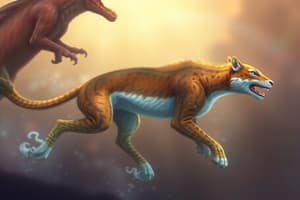Podcast
Questions and Answers
Animal movement from one place to another is called ______.
Animal movement from one place to another is called ______.
locomotion
The seasonal movement of animals from one place to another in search of food, shelter, or breeding grounds is called ______.
The seasonal movement of animals from one place to another in search of food, shelter, or breeding grounds is called ______.
migration
The movement in response to a stimulus, without a specific direction is called ______.
The movement in response to a stimulus, without a specific direction is called ______.
kinesis
The movement in response to a stimulus, with a specific direction is called ______.
The movement in response to a stimulus, with a specific direction is called ______.
The contraction and relaxation of muscles to move body parts is called ______ movement.
The contraction and relaxation of muscles to move body parts is called ______ movement.
Skeletal muscles are attached to ______ and are used for voluntary movement.
Skeletal muscles are attached to ______ and are used for voluntary movement.
The movement using fluid pressure, found in animals without a rigid skeleton is called ______ movement.
The movement using fluid pressure, found in animals without a rigid skeleton is called ______ movement.
The movement using cilia, found in some single-celled organisms and invertebrates is called ______ movement.
The movement using cilia, found in some single-celled organisms and invertebrates is called ______ movement.
The movement of legs in a specific pattern, found in animals with legs is called ______.
The movement of legs in a specific pattern, found in animals with legs is called ______.
The movement through water, found in fish and some aquatic animals is called ______.
The movement through water, found in fish and some aquatic animals is called ______.
Flashcards are hidden until you start studying
Study Notes
Animal Movement
Types of Movement
- Locomotion: movement of an animal from one place to another
- Migration: seasonal movement of animals from one place to another in search of food, shelter, or breeding grounds
- Kinesis: movement in response to a stimulus, without a specific direction
- Taxis: movement in response to a stimulus, with a specific direction
Mechanisms of Movement
- Muscular Movement: contraction and relaxation of muscles to move body parts
- Skeletal Muscles: attached to bones, used for voluntary movement (e.g. walking, running)
- Smooth Muscles: found in internal organs, used for involuntary movement (e.g. digestion)
- Cardiac Muscles: found in the heart, used for involuntary movement (e.g. heartbeat)
- Hydrostatic Movement: movement using fluid pressure, found in animals without a rigid skeleton (e.g. worms, jellyfish)
- Ciliary Movement: movement using cilia, found in some single-celled organisms and invertebrates (e.g. paramecia, corals)
Examples of Animal Movement
- Walking: movement of legs in a specific pattern, found in animals with legs (e.g. humans, dogs)
- Swimming: movement through water, found in fish and some aquatic animals
- Flying: movement through air, found in birds, insects, and some mammals (e.g. bats)
- Crawling: movement using the entire body, found in animals without legs (e.g. snakes, worms)
Importance of Movement
- Survival: movement is necessary for finding food, escaping predators, and reproducing
- Adaptation: movement allows animals to adapt to their environment and respond to changes
- Evolution: movement has played a key role in the evolution of animal species and the development of new traits
Types of Animal Movement
- Locomotion is the movement of an animal from one place to another
- Migration is the seasonal movement of animals in search of food, shelter, or breeding grounds
- Kinesis is the movement of an animal in response to a stimulus, without a specific direction
- Taxis is the movement of an animal in response to a stimulus, with a specific direction
Mechanisms of Animal Movement
Muscular Movement
- Involves the contraction and relaxation of muscles to move body parts
- Skeletal muscles are attached to bones and used for voluntary movement, such as walking or running
- Smooth muscles are found in internal organs and used for involuntary movement, such as digestion
- Cardiac muscles are found in the heart and used for involuntary movement, such as the heartbeat
Non-Muscular Movement
- Hydrostatic movement uses fluid pressure and is found in animals without a rigid skeleton, such as worms and jellyfish
- Ciliary movement uses cilia and is found in some single-celled organisms and invertebrates, such as paramecia and corals
Examples of Animal Movement
- Walking involves the movement of legs in a specific pattern and is found in animals with legs, such as humans and dogs
- Swimming involves the movement of an animal through water and is found in fish and some aquatic animals
- Flying involves the movement of an animal through air and is found in birds, insects, and some mammals, such as bats
- Crawling involves the movement of an animal using its entire body and is found in animals without legs, such as snakes and worms
Importance of Animal Movement
- Movement is necessary for survival, as it allows animals to find food, escape predators, and reproduce
- Movement allows animals to adapt to their environment and respond to changes
- Movement has played a key role in the evolution of animal species and the development of new traits
Studying That Suits You
Use AI to generate personalized quizzes and flashcards to suit your learning preferences.




